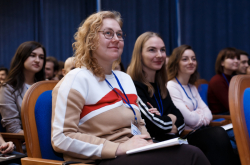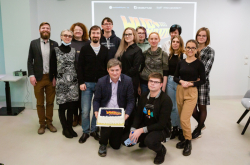The timing of the WUD@ITMO conference is a nod to World Usability Day, or Make Things Easier Day, a worldwide event promoting the values of user-centered design that has been celebrated annually since 2005. In 2015, ITMO University’s Center of Usability and Mixed Reality (previously known as Design and Multimedia Center) joined forces with Tallinn University to host the first WUD@ITMO summit. Since that time, the event has grown both in scale and popularity, starting to attract top experts from universities and large companies alike. This year’s ranks of conference participants included specialists from Russia’s national bank Sberbank, a prominent design agency ‘Sobaka Pavlova’, and many other big players in the field.
According to one of the conference’s organizers, a leading engineer at the Center of Usability and Mixed Reality Andrey Balkanskiy, the main goal of WUD@ITMO is to combine theoretical and practical approaches for the best results.
“We want to tell our audience about the most fundamental aspects of human-computer interaction and interface design: human perception and psychology,” shares Andrey. “We did invite design practitioners, but WUD@ITMO can hardly be called a meetup.”

How to teach people to move?
Vladimir Tomberg, associate professor at Tallinn University, dedicated his WUD@ITMO to the upcoming trends in the field of design. For one, Prof. Tomberg forecasted the future shift away from the usual 2D displays to the more avant-garde solution of screens that are built into clothes. One of the main reasons underlying this sea change is the aging of the population. While in 1950 the ratio between those who were fit for work and the ones who weren’t came down to 12 to 1, by 2050 it is predicted to be a mere 2 to 1. This is due to the universal progress in medicine with the consequent prolongation of the population’s life span, and the no less ubiquitous drop in birth rates. What these factors bode to us humans is that in the future, we’re likely to live in societies predominated by older people.
Human capabilities change with age. Starting from 25 years old, our ability to process new information takes a downward slope, the next to suffer are our mathematical skills. The only solace is that our verbal skills remain at their usual high for the whole duration of our lives, and there’s little wonder in that: however old we get, our propensity to have a good ol’ chinwag doesn’t really dwindle that much. All these aspects need to be factored in for designers to develop effective interfaces that meet the requirements of tomorrow.
As part of his work at Tallinn University, Vladimir Tomberg runs a laboratory with projects on designing wearable devices for human health and well-being. Their main area of focus, though, is human movement.

“Most of today’s health threats are linked to the sedentary lifestyle a typical 21st century human leads, as well as their inability to move in the right way. How should we walk, sit, bow down, and lift heavy objects without undermining our health and having to spend a week on the couch recovering? It would be ideal if each human had a personal trainer guiding them throughout their life, but this is obviously unrealistic. What we can do instead though is create supporting devices and boost our clothing with special interfaces,” highlights Vladimir. “That is the goal of the BetterSelf project we’re carrying out in our lab. To create a useful and usable product, we’re creating a comprehensive framework that combines the findings of several research fields: kinesiology, or the study of movement; personal informatics, or the gathering of information from movement trackers; adaptive technologies; human-computer interaction design and the psychology of learning. All these are integral to our work.”
Tallinn University’s own summer and winter schools include a course on experimental design of human-computer interactions. Its program has been developed on the basis of an interdisciplinary blend of design, technologies, engineering and art, giving students an opportunity to create versatile devices with applications in different fields, from medicine to theater. But preparing the participants for launching a finished product on the market isn’t the primary objective for the school organizers; according to Prof. Tomberg, what they want to achieve first and foremost is to provide them with a real-world experience of creating functional interfaces. Each year, Tallinn University’s summer and winter schools welcome students from leading higher education institutions of Japan, Spain, Germany, the US, South Korea, Azerbaijan, Georgia, Sweden and Russia, ITMO University included.

Design models
Vladimir Tomberg wasn’t the only Tallinn University representative partaking in the 2018 WUD@ITMO conference: he was joined by the Professor of Interaction Design David Lamas, who surprised the audience with the revelation that interface design is in fact a very old pursuit. Although the technologies which advance these developments, and which the latter are aimed at, is a relatively new phenomena, humans have been doing design since time immemorial, decorating caves, building cathedrals, and giving rise to entire cities. Architecture, urban science, and sound design are all branches of the selfsame tree.
The lecturer proposed that designers explore other scientific fields and look back at the available design solutions for solving complex professional problems and finding inspiration. One of the seminal design solutions mentioned by Prof. Lamas was the Basic Design Cycle model, which was developed in 1955 and implies a simple sequence of steps that includes analysis, synthesis, formulation, evaluation and final decision, with the underlying assumption that a designer has a clear vision of what they’re doing. The Basic Design Cycle is great for working with clients, because it gives them an insight into all the stages of a project, and this has a positive effect on how much they would want to pay.
Another of the most influential models in the field of design, V represents the design process as one moving from the specific to the abstract and vice versa: a designers takes a specific task they’re commissioned, brainstorms solutions, tests them, and brainstorms some more, following this task through to the end result.
Interactive design specialists may also want to look into the concept of human-centered design for interactive systems, which breaks the creative process down to four different stages: understanding and defining the context a future product will be applied to, identifying the target audience and their needs, developing an apposite design solution and comparing it to this predefined framework.

“Unfortunately, these models don’t reflect our daily practice and challenges as designers,” says David. “I am aware of this much-lamented rift between designers and developers. But squandering our time on heated debates leads to nothing useful; what we have to do instead is to unite and work for the good of the end product and, ultimately, users. Developers should be included in the process from its very get-go, it’s the only way for us to create the highest quality solution possible. Another root cause of many problems our field faces is that the majority of interactive designers have a very poor understanding of the materials digital products are made from. All architects begin their training by studying the structural complexities of cement, wood, and glass. They would laugh at the notion of designing something without knowing the materials to build from. We have to follow their lead, by studying the ‘matter’ first and only then proceeding with the design.”





